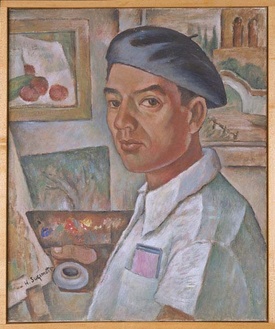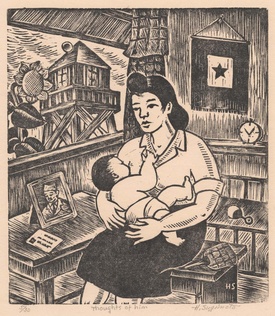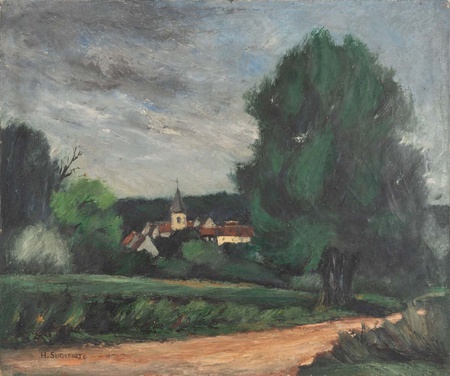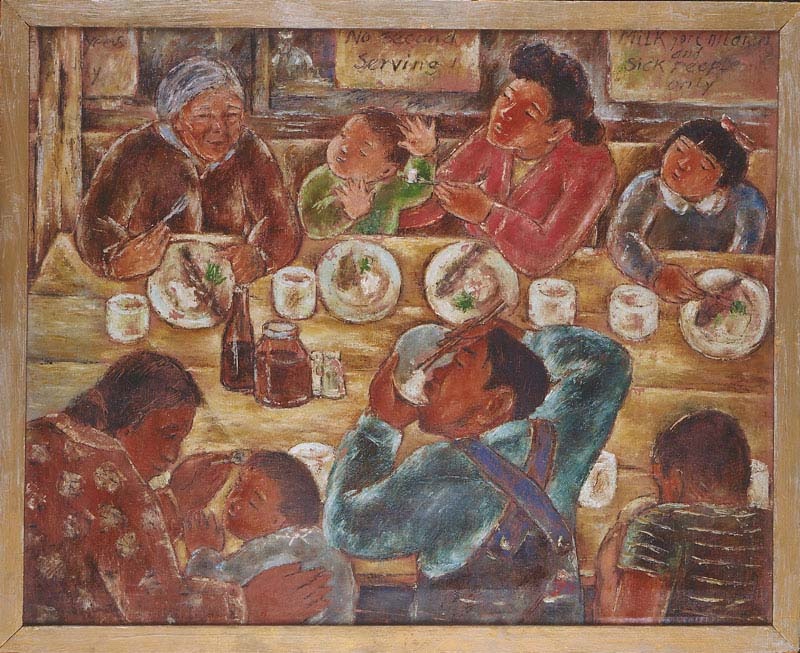In the heart of the Japanese American National Museum, a treasure trove awaits those who venture to explore the life and works of the prolific artist Henry Sugimoto. As a Collections and Curatorial intern at JANM this summer, I had the privilege of delving into this expansive collection. My work included cataloging, accessioning, and curating an online exhibition as my final project.
The story of Henry Sugimoto (1900–1990) is one of resilience, creativity, and the power of artistic expression. Hailing from Wakayama, Japan, Sugimoto made his way to California in 1919, where he studied art and achieved considerable success exhibiting in galleries and museums. His work ranges in style and subject matter, from serene scenes of the French countryside to striking depictions which narrate the Issei immigration experience as well as the challenges of the World War II incarceration.
The Henry Sugimoto collection at JANM encompasses his entire six-decade career, from the 1920s to his passing in 1990, and includes over 1,500 oil and watercolor paintings, woodblock and linocut prints, and ephemera. Needless to say, the volume is prodigious. In fact, it is the Museum’s largest collection of artworks by a single artist, thanks to Henry Sugimoto’s daughter, Madeleine, who generously made several large donations of her father’s works to the Museum.
As I surveyed the vast collection during the initial days of my internship, I was struck by Sugimoto’s dedication to his artistic pursuits—not only does the sheer volume of his works speak to his commitment to his artistic career, but also his perseverance in painting throughout his incarceration during World War II. As Sugimoto later reflected, he “depicted camp life… with an artist’s sense of mission.”

His only self-portrait from camp encapsulates his determination as an artist—he portrays himself wearing a beret with a palette, easel, and canvases. As I familiarized myself with the collection and Sugimoto’s life, I felt a responsibility to take great care in preserving his works and in exhibiting them to the public to share his story.
The majority of my work this summer involved the meticulous endeavor of inventorying and cataloging the collection. I started by working through the large body of Sugimoto’s wood and linoleum cut prints. Although they are lesser known than his oil paintings, they are personally some of my favorite works in the collection.

The prints showcase a range of styles and subjects, from scenes of New York to images reminiscent of his Japanese heritage. Among these prints, there are poignant depictions of daily life in incarceration, with reminders of the harsh realities of camp, such as guard towers and barbed wire fences, looming in the background.
The inventorying and cataloging processes involve many steps that precede an object being available for viewing online. I first began by sorting and organizing the collection of prints. Because there were many copies of each, scattered across many different boxes, my first few days resembled the card game memory, trying to match like-prints. Once I organized the works, I rehoused them into archival storage materials, replacing the original cardboard boxes and folios they came in over twenty years ago.
Next, I began to catalog them, which involved assigning each a unique accession number and physically labeling the artwork, taking measurements, writing visual descriptions, and counting copies of each one. Then, with the help of the digitization specialist Tori Ishikawa, I scanned or photographed each unique print, edited the images, and finally, uploaded all the images and information for each piece to an online database to make them accessible online to the public. By the end of this process, I tallied a grand total of 1,950 prints, which was really 126 unique prints.
A similar process ensued for the paintings, which depict impressionist-styled scenes from California, France, Mexico, New York, Arkansas, and Japan. I was particularly drawn to his oil landscapes from the French countryside, which hone a rich earth-toned palette and explore compositions with church buildings, windblown trees, haystacks, and winding paths. In total, I cataloged 510 paintings.

As I started thinking about my final internship project, I first and foremost wanted the public to experience this incredible collection. Sugimoto’s work had not been displayed at JANM since the 2001 exhibition Henry Sugimoto: Painting an American Experience. Inspired by the great range of style, medium, and subject matter, I decided to curate a new online exhibition, Henry Sugimoto’s Artistic Evolution, to showcase the evolution of his artistry throughout his prolific sixty-year career.
The resulting exhibition, now on the JANM website, serves as a virtual timeline, guiding viewers through five different periods of Sugimoto's career. Each time period includes a gallery of curated pieces accompanied by a brief description, offering insight into the artist's life at the time that influenced his works. To see more of Sugimoto’s works, we invite viewers to explore the rest of the collection, viewable on e-Museum and linked under the online exhibition related resources.
As I wrap up my internship, I am left with a deep sense of admiration for Henry Sugimoto's dedication, resilience, and artistic passion. Working with his collection has been a privilege, one that has underscored the importance of preserving and sharing the stories embedded within each artwork. Through this new online exhibition, I hope that we help Sugimoto’s legacy to remain vibrant, relevant, and an important contributor to the historical and art historical narrative of the 20th century.
* * * * *
*View the online exhibition Henry Sugimoto’s Artistic Evolution at janm.org/henry-sugimoto
© 2023 Maya Lee



